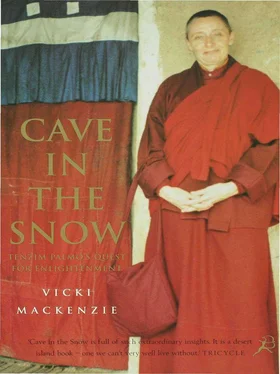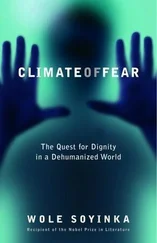Who Tenzin Palmo was, or had been, exactly, was difficult to establish, she being particularly vague on the subject. ‘I think I had been a monk for many lifetimes and that my relationship with Khamtrul Rinpoche started a long time ago. That’s why when we met again it was just a matter of taking up where we left off. I think I was his attendant monk, or something like that. Once a lama said to me in some amazement, “Don’t you know who you were in your last lifetime?” and when I said “No” and would he mind telling me he replied, “If Khamtrul Rinpoche hasn’t told you he must have his reasons.” But I never asked,’she said.
’The thing is we met and we recognized each other, and that was enough,’ she added. ‘Khamtrul Rinpoche did say that we had been very close for many lifetimes. He also commented that because this time I had taken female form far away from him in the West it had been difficult for us to be together but that in spite of this he’d always held me in his heart.’
Later, more specific information of her past lives was revealed. Tenzin Palmo suspected that in one lifetime she had been a yogi, very close to the sixth Khamtrul Rinpoche, who lived earlier this century. The sixth Khamtrul Rinpoche had left the Khampagar monastery, got married and gone to live in a cave on the opposite side of the mountain to the monastery. He was a great yogi who boasted among his disciples the famous Shakya Shri, regarded as one of the greatest meditators of the century. It was said that Shakya Shri received teachings from Milarepa himself while in the clear light. Presumably Tenzin Palmo, in her past life, knew them both.
Here finally was the answer perhaps to many of the enigmas of Tenzin Palmo’s life: why she had felt perpetually ‘wrong’ in London; her strange unfamiliarity with a female body as a child; her natural affinity with Tibetan Buddhism, especially the Kargyu sect; her spontaneous wish to become ordained; her announcement to the Dalai Lama that she was from Kham. If she had been a man, a monk and a meditator in eastern Tibet for many lifetimes it would all make sense.
Why she had been born a Westerner and a woman this time round was, however, a matter of speculation.
As she had said, she was now poised to take up the relationship with Khamtrul where she had left off, this time not as a monk or a lama but as a novice nun. She left Mrs Bedi’s school and began work as Khamtrul Rinpoche’s secretary, a position which meant she came into close contact with him on a regular basis. Again it was only the strangeness of the times which made such a thing possible. Had she been born back in Kham, as a woman he might have well recognized her but protocol and centuries of traditions would have demanded he send her off to one of his nunneries. In close proximity she got to know him again.
‘He was a tall man, heavily built, but like many big people he was surprisingly light on his feet. He was an excellent “lama dancer" and a very accomplished painter as well. Quite famous among his own people. He was also a poet and a grammarian,’ she began. ‘His presence was also very big but he was extremely sweet and gentle, with a very soft little voice.’ Her voice became soft itself in the memory. ‘I was terrified of him. It’s interesting that one felt this kind of awe. He was considered to be one of the fierce forms of Guru Rinpoche (also known as Padmasambhava, the man credited with bringing Buddhism to Tibet from India in the eighth century), and sometimes people would see him in that form. So I guess that’s what it was. On the outside he was very sweet but you sensed this great force that was inside him.
‘One evening I was typing when Khamtrul Rinpoche came in looking very tired. He glanced over at me, I looked at him and for a moment it was as if the mask had dropped and I was hit by a thunderbolt. I jumped and then I started shaking. It was as though an electric current had gone all the way through me. He immediately got up and came over. “I’m so sorry I would never have done that for the world. I’m so sorry,” he said. He got one of the monks to take me home and I spent the whole night just shaking. It was like that. He had this enormous power which all the time he was trying to keep in. But really he was extremely kind, funny and very loving. Some people found him remote and detached, but to me he was affectionate. He would hold my hand, stroke my face and was very nurturing – like a father and a mother combined.
‘It was a beautiful relationship,’ she continued. ‘It was very simple, very uncomplicated. I never ever doubted who my lama was. He never doubted that I belonged to him. He always said, “You are my nun.” Even when I became very connected to other lamas, the interrelationship was not there. I would sit with people like Sakya Trizin (head of the Sakya School) who became my second lama and suddenly get this great feeling of homesickness for Khamtrul Rinpoche. It’s like with your mother – there may be other people who you admire and like but that special feeling you have with your mother you can’thave with anyone else,’ she said.
‘You see, the relationship with your lama is so intimate, and on such a deep level, it’s not like any other. How can it be? It’s a relationship that has been going on for lifetime after lifetime. Your real lama is committed to you until Enlightenment is reached. What could be more intimate than that?’
Another person who knew Khamtrul Rinpoche intimately was Choegyal Rinpoche, one of his chief disciples, who had been with him in Kham. He threw more light on just who the guru was.
‘He was amazing. His mind stayed the same whatever happened. I noticed that he was exactly the same here in India, as a refugee, as he was in Tibet when he had so much power and status. He’d didn’t mind that he had to go and buy the cement and build the monastery himself. He’d throw his arm around the Indian shopkeepers, joke with all the locals, people really loved him. He was also very ecumenical, very broad. He would meet with Moslems and Hindus alike and discuss their religions with them,’ he said.
Tenzin Palmo, aged twenty-one, had renounced a lot – her family, her country, her background, her hair and all aspirations of worldly accumulations, but there was one area of her being that had yet to be resolved. Shortly after her ordination she received a letter from John Blofeld, inviting her to his home in Thailand, to spend some time with his wife and himself.enzin Palmo thought it an excellent idea. Thailand was a Buddhist country, John was sympathetic, and the conditions in his house were bound to be more conducive to do a meditational retreat than those in Dalhousie. She asked Khamtrul Rinpoche’s permission and he said, ‘Yes, but come back quickly.’
When she arrived at John Blofeld’s house she found her Japanese boyfriend there as well. She had written to him telling him she had become a nun and that therefore the engagement was off, but he had heard from a mutual friend that she was going to Thailand, and decided to try his chances yet again. Undeterred by her bald head and shapeless robes, he pressed her once again to marry him. Tenzin Palmo hesitated. She was only a novice nun and Khamtrul Rinpoche in his wisdom had only given her the one vow ‘not to kill’. The Japanese boy was as attractive as ever.
‘We got on just great. We felt completely at ease with each other, as though we’d known each other for always. It was a very mellow relationship. He was a lovely, lovely person,’ she said. ‘One time he swatted a mosquito. I said, “What are you doing?" I went on through this whole thing, how mosquitoes have feelings and that just as our life is precious to us, for a mosquito the most precious thing it has is its own life, and as we don’t want anyone to squish us, so we shouldn’t take the life of another being because while we could take it we could never give it back. By the end of it he was in tears. “Why has nobody ever said this to me before?” he said. He had such a kind heart. He never said a mean thing about anyone, ever. He was just so sweet and intelligent. He was exceptional, very very exceptional. I thought it unlikely I’d ever meet anyone like that again. And so the idea of giving him up was a renunciation,’she recalled.
Читать дальше












